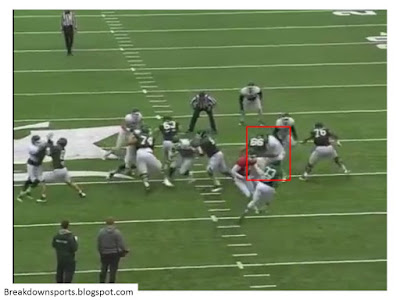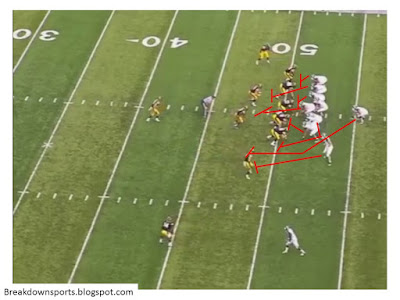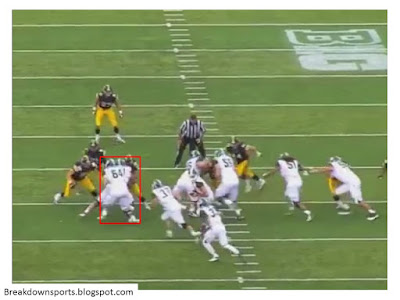Title : Inside the Playbook: Michigan State Pin and Pull
Review : Inside the Playbook: Michigan State Pin and Pull
Inside the Playbook: Michigan State Pin and Pull
Coming off of one of the least productive years for the MSU OL in some time, the Spartans have largely retooled the unit and are planning to press quite a bit of youth into the starting lineup. Their current starting line up and key rotational players look like this:| Position | LT | LG | C | RG | RT | LT2 | OG2 | C2 | OT3 |
|---|---|---|---|---|---|---|---|---|---|
| Player | C. Chewins | T. Higby | B. Allen | D. Beedle | L. Campbell | D. Finley | K. Jarvis | M. Allen | J. Reid |
| Year | RS-SO | RS-SO | SR | RS-JR | RS-FR | RS-SR | FR | RS-FR | FR |
| Height | 6-8 | 6-5 | 6-2 | 6-5 | 6-5 | 6-7 | 6-4 | 6-3 | 6-4 |
| Weight | 284 | 293 | 302 | 329 | 293 | 307 | 312 | 301 | 271 |
I would argue some of these weights are likely getting a "college roster" bump as well. This is not the beefiest of beef units to set foot in Spartan Stadium. Not that long ago though, Michigan State featured one of the most diverse run blocking playbooks in the league, right up there with Harbaugh's Michigan teams. They ran Power, Counter, Sweeps, Traps, Inside Zone, Outside Zone, and yes, Pin and Pull. But as the skill diminished, so did the playbook, and the settled into mostly an inside zone team with some Power to balance things out last year. This year, they feature that undersized but mobile unit listed above, and the emphasis should move away from "let's push people off the ball" and focus more on "let's force the defense to move with us and let's rely on angles to get run gaps". This should lead to more outside zone and Pin and Pull, which will be the topic of this article.
Previously
I've talked about outside zone several times and pin and pull numerous times as well. Really, there isn't much changing. The idea is that on the backside of the play, you essentially run your outside zone cover/uncovered rules. On the front side, if you have a guy lined up inside, you pin him down. If you don't, you pull around and find a second level blocker. The beauty of the pin and pull is the conflict it puts on the front 7 of a defense. The down blocks and pullers give more advantageous angles, and combined with a stretch scheme, it makes it difficult for the defense to quickly read and get to their "spots" to prevent to play from succeeding.
But MSU does a thing or two a little differently than what I've previously described, and I want to touch on those things.
Outside Zone Blocking
For the basic stretch play, MSU utilizes two different blocking types: "Zone Reach" and "Tight Reach".
Zone Reach
MSU utilizes a zone reach technique when you have help coming from an uncovered OL to the backside of the play.
The first step should be the playside foot pointing outside the outside shoe of the defender. The second step is the backside foot splitting the defender's crotch. The third step (playside foot) needs to establish outside leverage and start gaining upfield verticality.
The inside hand of the blocker will drive through the down hand (defender's inside hand) and drive it through his chest. Taking away this hand doesn't allow the defender to control the blocker and allows the blocker to move more freely to gain leverage. The outside hand should be working to gain leverage on the outside of the defender's chest plate.
Tight Reach
This is when the OL next to you and on the backside of the play cannot help combo.
Footwork starts the same as the "zone reach", but the hands are different. Here, rather than punch through the defender's down hand, you shoot your hand through the sternum, and it goes to the near breast plate. The goal of this block is not to get vertical displacement, but to utse teh defender's momentum to drive him out of the play.
If you are uncovered, you are to perform what MSU calls a "short pull". In this blocking technique the blocker is working through the near knee of the defender and by the third step deciding if he needs to continue helping or if he can work to the second level. First step is pointed to the playside foot of the defender and is a lateral step. Second step starts getting vertical, third step is the decision whether to stay on the block or release.
Pin and Pull Tags
MSU uses a tag system which allows them to apply certain pin and pull schemes whenever they want in game. This means they could start out with a combo block one the 1T to start the game, but perform a CAGE block later in the game (down block with the playside guard, have the center fold around). They can also TAG (tackle and guard), TEX (tackle and end) where the inside guy folds around the downblock of the outside blocker. And at times they will pull the backside OG and fold him around the Center with what they call "Badger"
Fold Block
The first aspect of MSU's pin and pull scheme that is different than many is that it isn't necessarily about getting the ball to the outside. Sure, they don't mind pinning the defense inside and bouncing the play. But the pullers aren't going to pull around the entire front just because that's the design. In fact, if possible, they will prefer to "fold block" when given a clear run to the second level.
Here's what that looks like:
From the sideline
From the Endzone
In action. The red box is the puller. Notice that the puller gets tall. MSU employs a skip pull (a sort of shuffle slide) in which the puller will pop up, gain some depth, keep his eyes on his target, and then work forward.
(Near the same point in time)
Notice the center working up to the backside LB level and cutting him off while the puller is getting to the front side LB.
This can be seen at 1:06 of the Vimeo video below.
What this means, in theory, is that that down blocker and the fold blocker are switching zones. This is an important point, because it means they aren't just folding to get one guy to the second level, they are folding to improve the down block angle, but the "puller" of "folding" blocker still has to abide by the zone blocking rules. Which means when a DE spikes inside, it is the fold blocker's job to gain outside leverage on the spiking DE. MSU calls this dealing "with a 5er" (or a guy spiking inside to from a 5 technique; on the strong side of the formation it's called dealing "with a 9er").
See at the snap, the DE begins spiking inside. The OT is going to let him go with a little shove and begin working to the second level. The Center, who has popped up to begin his skip pull, needs to first look for this DE spiking inside. Remember, he is switching zones with the OG, this DE is the first to come into his zone. The RB, who should be reading the defensive EMOL, should see all this happening in front of him and adjust. He now knows he isn't cutting inside that EMOL as he typically would, but is looking to bounce outside of him.
Now the center and DE are fully engaged.
Notice the center's feet here. He's getting his inside hip low and he's really anchored with his outside foot. This allows him to turn that DE inside, allowing the RB to work outside.
This can be seen on the first two plays from the Vimeo video below.
Cross Block
Another adjustment that MSU will make is what they call a "Cross block". This is used against DLs that tend not to over penetrate, but instead try to squeeze down on downblocks and control the LOS. If the DE tries to play tight to the down block, MSU will down block on a 3T and fold around with the playside Guard to seal the DE inside.
Notice the DE is not working down hill, he is sliding with the downblock, trying to constrict the outside. A lot of teams will do this when facing zone based offenses to try to form a wall at the LOS.
The OG starts engaging as the FB works to the playside LB.
And again, a great job getting outside leverage and sealing the DE inside, allowing the RB outside.
This can be seen at 4:30 in the Vimeo Video below.
Links
Here is a cutup of Pin and Pull schemes (Vimeo Video)
Pin and Pull Concept- Michigan State University from Eddie Ostipow on Vimeo.
Mike Kuchar at X and O Labs also did an in depth look at the MSU Pin and Pull scheme. Here's a link to the article (need insider access for the entire thing, which I don't have). More importantly for me, he provide a lot of nice cut-ups to easily embed here.
Stretch scheme:
Pin and Pull:
Conclusion
This pin and pull scheme, in combination with the stretch scheme, allows MSU to be the athletic front that they are, and doesn't rely on them getting great movement at the 1st level to control the LOS. In this way, they have advantageous angles with down blocks, and a diverse but singular scheme, that with reps, can go against any front with fairly simple rules. In this way, they can mask some of their weaknesses and bring to focus what should be their strengths.
Such is the Article Inside the Playbook: Michigan State Pin and Pull
sports films Inside the Playbook: Michigan State Pin and Pull, hopefully can be useful for all of you. Alright, that's all for posting reviews of sports films this time.




























0 Response to "Inside the Playbook: Michigan State Pin and Pull"
Post a Comment